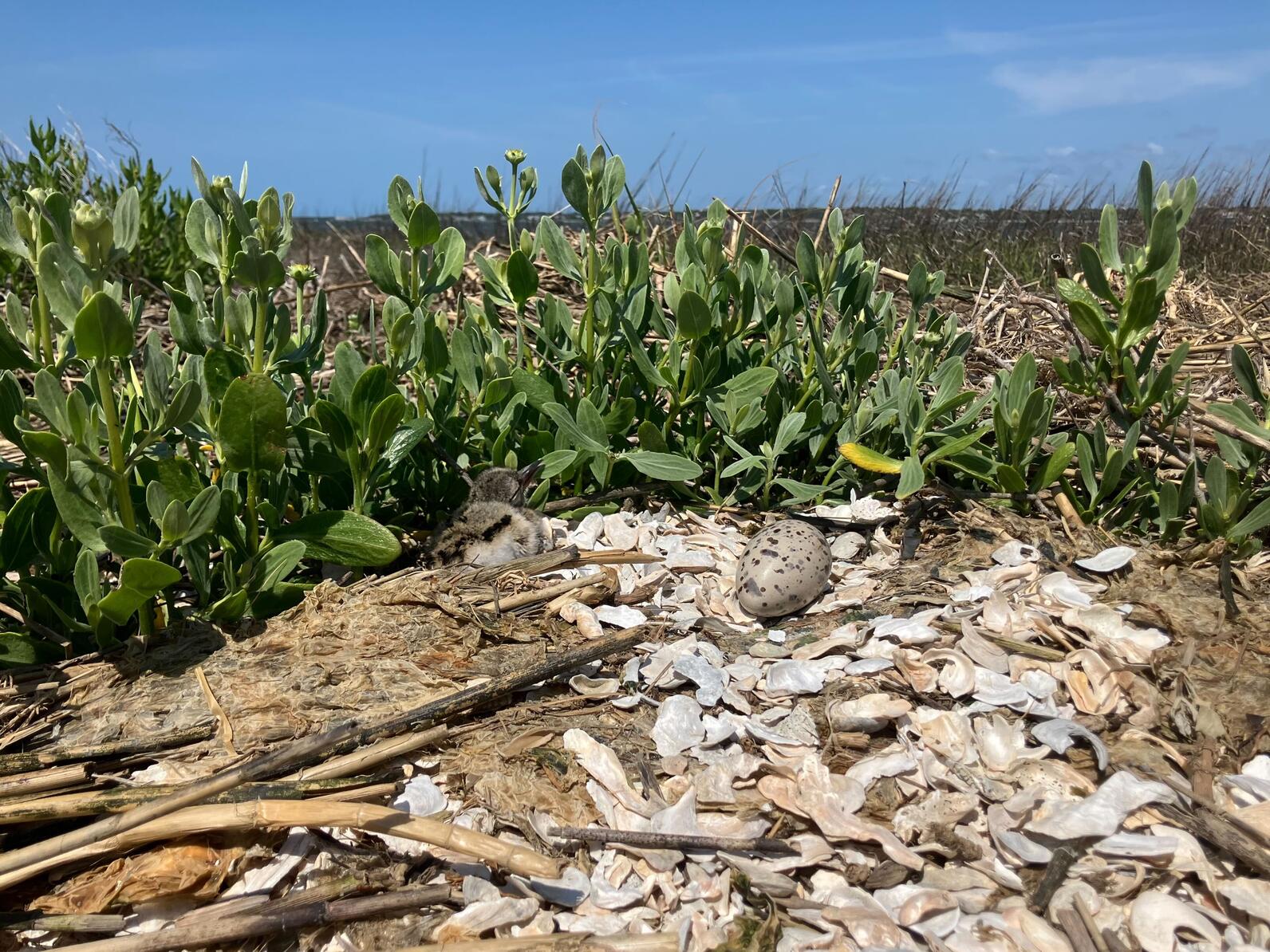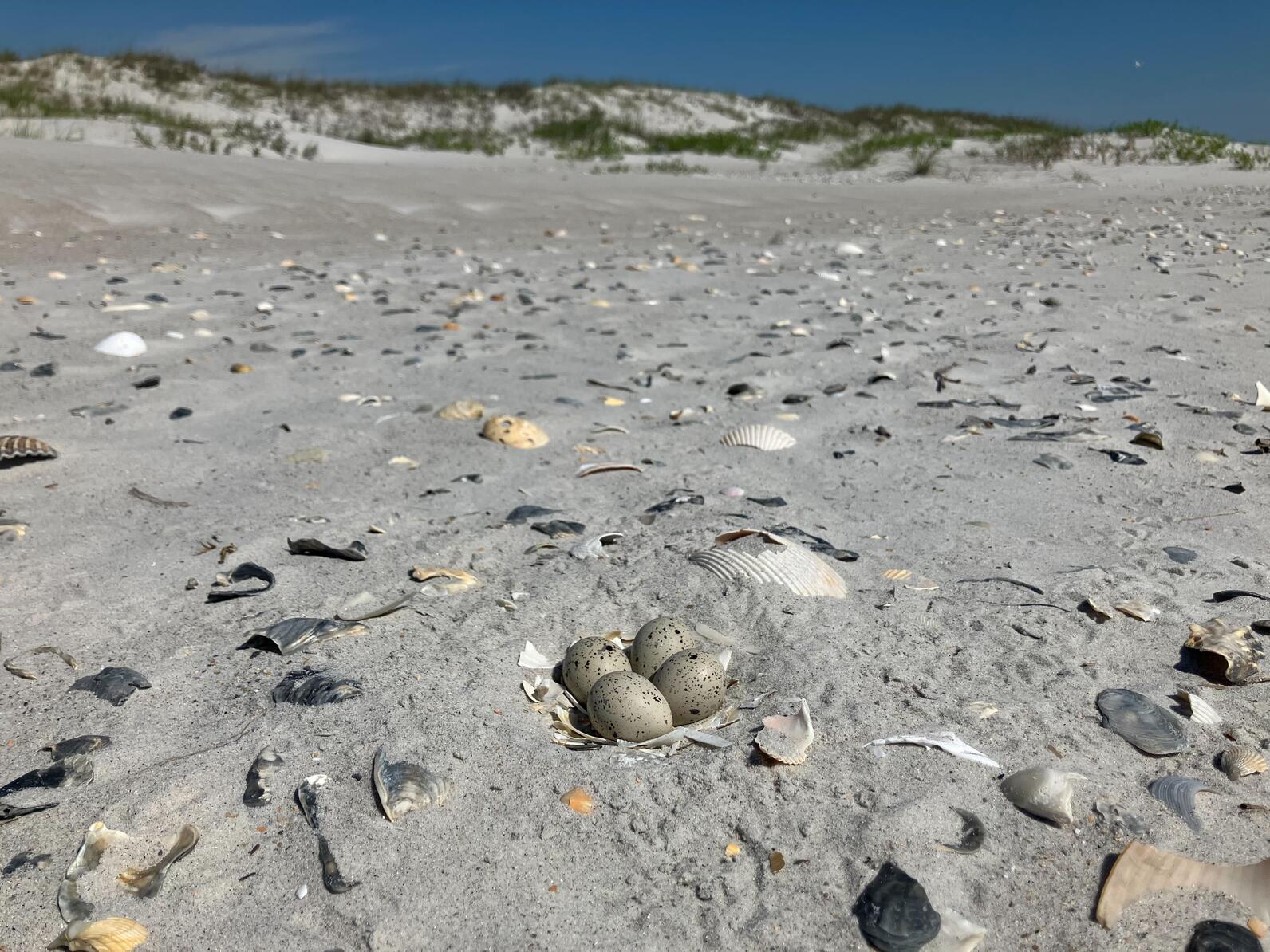From the Cape Fear River to Pamlico Sound and beyond, coastal birds are already raising the next generation of chicks this spring and summer. American Oystercatchers are scurrying after their long-legged chicks on the river, Least Terns and their fish-loving babies are thriving on barrier islands, and Royal and Sandwich Tern chicks are finding their way amongst colonies that number in the thousands.
Early in the spring when it’s still cold and birds are just starting to return for the breeding season, our coastal team and volunteers headed out to Lea-Hutaff Island, Wrightsville Beach, and the rest of our sanctuaries to rope off nesting areas. We put up more than 600 signs this year (and every year) to minimize disturbance to nesting birds. From March 1 to September 15, posted areas on the beach are a safe haven for nests and growing chicks.
Throughout the year, we monitor 19 islands and one beach site that support thousands of nesting coastal birds. Our monitoring efforts include conducting regular surveys, banding individual chicks, posting nesting sites, and just making sure our coastal birds have a place to rest, nest, and refuel.
Read on for an update on how our coastal birds are faring this year.
Special Projects
This year we’re continuing our partnership with Dr. Kate Goodenough, Lead Ecologist at Larid Research and Conservation, to track nesting Royal Terns on the Cape Fear River. “We’ve gathered an amazing amount of data from seven Royal Terns that returned with the GPS transmitters this spring,” said Coastal Biologist Lindsay Addison. “That includes brand new information about their migration routes and where they spent the winter.”
This spring we also coordinated the statewide American Oystercatcher and Wilson’s Plover census, which takes place every three years. Data going back over 20 years provides snapshots over time of abundance and distribution of these species on our coast. The state is organized into survey plots that contain suitable habitat, and partners including the NC Wildlife Resources Commission, the National Park Service, the U.S. Fish and Wildlife Service, and the NC Coastal Reserve fan out to visit each one.
Audubon's coastal team covered survey plots across much of the southern half of the state, and the next step will be to tabulate the data after the nesting season concludes. This census helps us track the long-term success of these priority species and update management practices as needed.
Cape Fear River
Thirty percent of North Carolina’s colonial—or group-nesting— waterbirds nest on the river. The islands that we manage here are home to colonies of terns, pelicans, ibis, and egrets and herons.
The colony of Royal and Sandwich Terns is back as usual on South Pelican Island and began hatching chicks in late May. These species almost exclusively nest on dredged-material islands in North Carolina, with 75 percent of colonies nesting on either South Pelican Island (Cape Fear River), Morgan Island (Core Sound), or Big Foot Island (Pamlico Sound).
Pelicans nest on South Pelican Island as well as on Battery Island, where large colonies of White Ibis and Great Egrets can also be found. On the river, egrets tend to nest in trees and dense grasses along with their smaller cousins, Snowy Egrets and Little Blue Herons.
“Pretty much everyone is raising and fledging chicks at this point in the season,” said Addison. “So, it is even more important for people to be cautious around posted areas and share the shore as much as possible.”
American Oystercatchers also have a stronghold on the Cape Fear River, with just under 100 pairs nesting there annually. Of those pairs, we closely monitor about 60 to track their nests and chicks to success or failure. When they fail, we try to determine causes and mitigate for those issues as much as possible.

This year, oystercatchers have been particularly successful with about half having hatched so far. On Ferry Slip Island—another dredged material island—there are 16 pairs along with Laughing Gulls, Willets, and Black Skimmers. “Hopefully this trend continues for the rest of the summer as chicks start to fledge,” said Addison.
Get a behind-the-scenes look at the hidden lives of these birds and Audubon’s work to protect them.
Lea-Hutaff Island
Just up the coast from Figure Eight Island is an undeveloped barrier island known as Lea-Hutaff, which is home to large colonies of Least Terns. There are 538 pairs on the Hutaff end of the island this year, and 394 on the Lea end. Coyote management early in the spring helped give these tiny terns a better chance of survival. Lea-Hutaff supports a large portion of the state’s Least Tern population—this year we expect it to approach one third—which makes management of this site even more important.
The island also hosts Willets, Wilson’s Plovers, Common Nighthawks, Green Herons, and 25 pairs of American Oystercatchers. A pair of Piping Plovers also recently hatched a nest on the island—an important feat for these federally threatened birds.

Biological technician Ashlyn Newberry, who monitors the island almost daily, recently discovered the season’s first sea turtle nest. “When I'm out on the island my job is to detect turtle crawls, maintain the bird postings, educate beachgoers, and make sure that the wildlife using the site has every possible chance to be successful,” said Newberry. “So far, everyone has had a very productive year.”
The south end of Wrightsville Beach
One of the most popular vacation spots for North Carolinians also happens to be where colonies of Least Terns and Black Skimmers nest. Because of how populated the beach gets in the summer, we have volunteer Bird Stewards who monitor the posting every day to educate beachgoers about what birds are nesting in the posted area and how they can share the shore.
This summer we have more than 80 Bird Stewards with 29 new volunteers joining us this year. They’re out on the beach seven days a week from sunrise to sunset—thanks to our amazing volunteer coordinate Marlene Eader.

This year there are 325 pairs of Least Terns at the site ranging from pairs with fledged chicks to pairs incubating eggs. The Black Skimmer colony is also active, with pairs courting and incubating. Thanks to the protection of the stewards, beachgoers are able to understand the importance of limiting disturbance and the birds are able to raise the next generation of chicks.
Want to see these birds for yourself? Audubon hosts free guided bird walks on the South end of Wrightsville Beach every Monday morning at 9 am through August 15.
Beacon Island and Shell Castle Island
These islands are some of our more far-flung sanctuaries, sitting in the Pamlico Sound near Ocracoke. This year, Beacon is home to Great Egrets, Glossy Ibis, and Black-crowned Night Herons. Meanwhile tiny Shell Castle has two pairs of oystercatchers and remarkably one has succeeded in raising two chick that are nearing fledging. Proof that given a bit of habitat, these remarkable coastal birds can succeed.
If you’re out on the coast this summer, make sure to respect posted nesting sanctuaries and share the shore—our coastal birds thank you.
*All banding, marking, and sampling is being conducted under a federally authorized Bird Banding Permit issued by the U.S. Geological Survey’s Bird Banding Lab.









